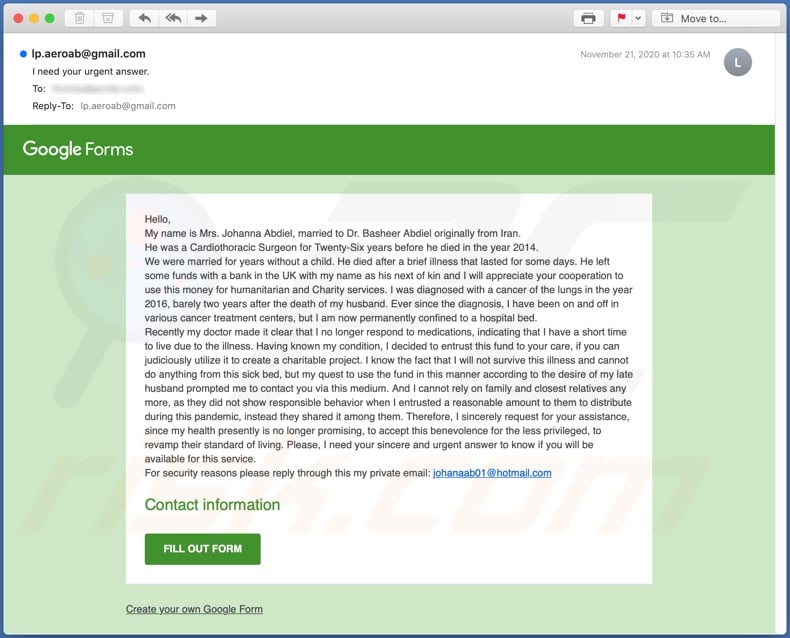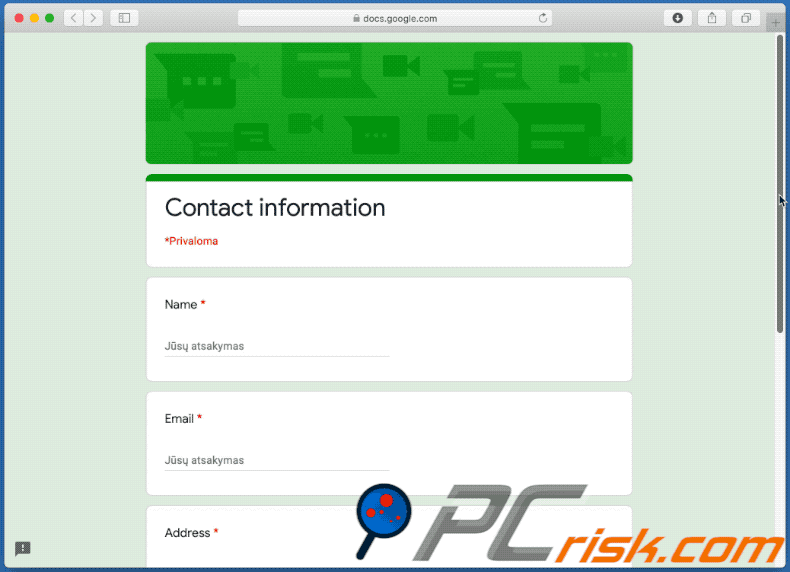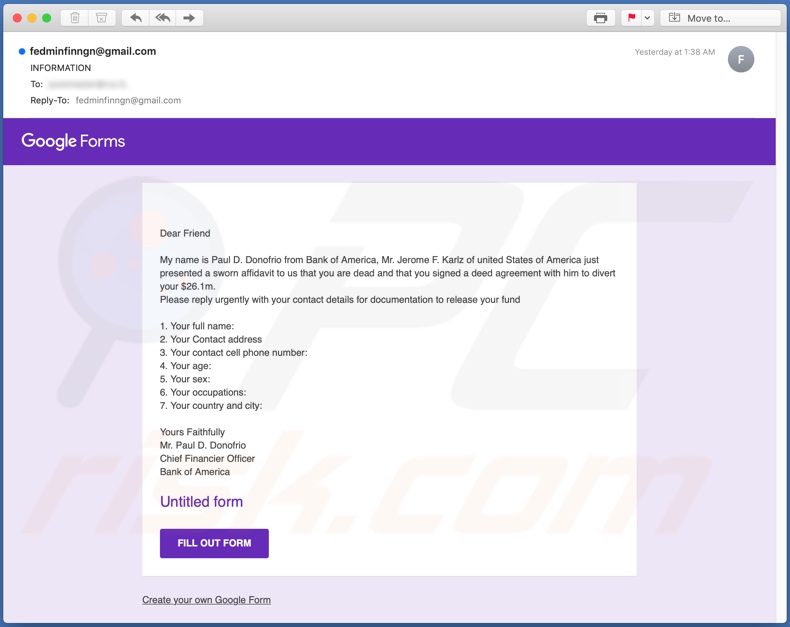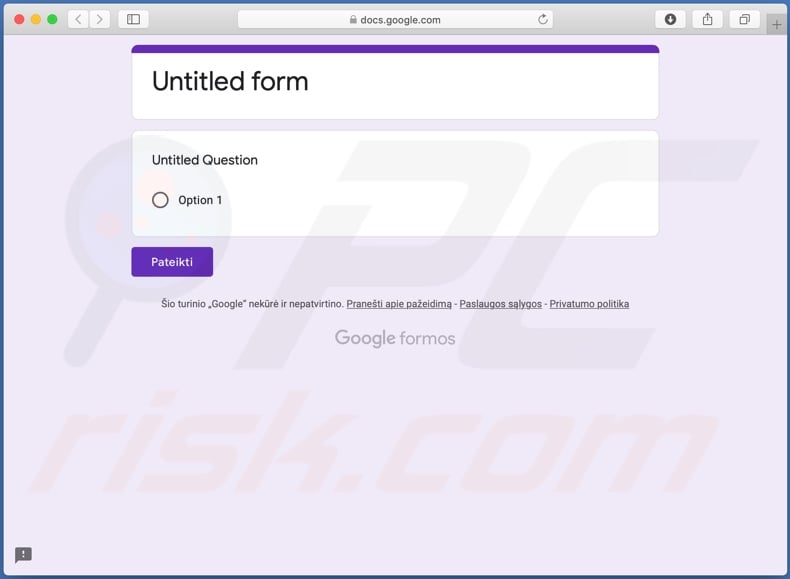How to spot scam emails that use Google Forms to steal private data
Phishing/ScamAlso Known As: Google Forms spam
Get free scan and check if your device is infected.
Remove it nowTo use full-featured product, you have to purchase a license for Combo Cleaner. Seven days free trial available. Combo Cleaner is owned and operated by RCS LT, the parent company of PCRisk.com.
What is the "Google Forms" email scam?
"Google Forms email scam" refers to a phishing spam campaign, which employs Google Forms to gather user data under false pretences. The term "spam campaign" defines a mass-scale operation, during which thousands of scam emails are sent. Google Forms is survey administration software, which is part of the Google Docs Editors suite.
At the time of research, there were two variants of this phishing scam distributed through the "Google Forms" spam campaign.
One email variant issues a story of a supposedly widowed cancer patient seeking the recipients' aid to distribute her wealth to charities. The other claims the recipient is deceased and that bank funds will soon be transferred out of associated accounts, unless proper action is taken.
Both versions contain links to surveys on Google Forms, which ask users to provide personal information. Note that the deceptive messages proliferated via the "Google Forms" spam campaign are scams and all information within them is false.
Therefore, any data revealed (i.e. entered into the questionnaires) will be exposed to the scammers behind this spam campaign.

More about the "Google Forms" email scam
The first variant of the "Google Forms email scam" (subject "I need your urgent answer." - this might vary) details a fake story of the supposed sender. The gist of the deceptive message is that it is from a dying cancer patient who has inherited an unspecified sum of money from her deceased husband.
This nonexistent person asks the recipient to receive the funds and distribute them to charitable organizations, projects, etc. Allegedly, the sender is near death and does not trust her family and close relatives to treat the inheritance as per her wishes.
This scam email contains a button, which leads to a Google Forms survey, asking users to provide the following information about themselves: name, email, home address and phone number.
The other variant's (subject "INFORMATION" - this might vary) story is not particularly rational. The message is from a Bank of America "representative", which informs the recipient that a named US citizen has presented an affidavit (written statement confirmed by oath/affirmation, used for evidence in court) confirming their (the recipient's) status as deceased.
Furthermore, the recipient has supposedly signed a deed that is to divert over $26 million (USD) to the person who presented the affidavit. Recipients are to respond immediately and provide their contact details for documentation purposes (likely, to stop the fake fund transfer).
The information requested is listed in the email as follows: full name, country and city, contact address, mobile phone number, age, sex, and occupation(s). This message likewise contains a button leading to a Google Forms questionnaire, however, unlike the survey promoted by the previous scam email version, this questionnaire is blank. It is likely that this will be rectified by the scammers in future and the survey will be fully functional.
As mentioned, all information provided by the "Google Forms email scam" message is false. The purpose of these message is to steal recipients' private data, which can then be used for a variety of dubious purposes.
To summarize, by trusting these scam emails, users risk experiencing serious privacy issues, financial losses, and even identity theft.
| Name | Google Forms Email Scam |
| Threat Type | Phishing, Scam, Social Engineering, Fraud |
| Fake Claim | One variant of the scam emails asks recipients to provide personal information so that funds can be distributed for charitable purposes. The reason for the data gathering given by the other variant is to prevent a person from taking possession of the recipients' funds. |
| Symptoms | Unauthorized online purchases, changed online account passwords, identity theft, illegal access of the computer. |
| Distribution methods | Deceptive emails, rogue online pop-up ads, search engine poisoning techniques, misspelled domains. |
| Damage | Loss of sensitive private information, monetary loss, identity theft. |
| Malware Removal (Windows) |
To eliminate possible malware infections, scan your computer with legitimate antivirus software. Our security researchers recommend using Combo Cleaner. Download Combo CleanerTo use full-featured product, you have to purchase a license for Combo Cleaner. 7 days free trial available. Combo Cleaner is owned and operated by RCS LT, the parent company of PCRisk.com. |
Similar scams in general
"WhatsApp Email Scam", "Account Access Disabled", "Email Quarantine", "National Lottery" and "Last Warning: Upgrade your email to avoid Shutting Down" are some examples of other phishing spam campaigns.
Emails of this type can target a broad range of information, ranging from users' personal data to the log-in credentials (i.e. IDs, usernames and passwords) of specific accounts. Deceptive messages are usually disguised in some manner such as as "official", "important", "urgent", "priority" and so on.
Note that phishing is not the only use of these emails - it is also used for other types of scams and even malware (e.g. Trojan, ransomware, etc.) proliferation.
How do spam campaigns infect computers?
Spam mail infects systems through virulent files attached to and/or linked inside them (note, the messages often contain download links). Infectious files can be in various formats such as Microsoft Office and PDF documents, archives (ZIP, RAR, etc.), executables (.exe, .run, etc.), JavaScript, and so on.
When these files are executed, run or otherwise opened, the infection process (i.e. malware download/installation) is triggered. For example, Microsoft Office documents (e.g. "Invoice_24077.xlsb") cause infections by executing malicious macro commands.
In Microsoft Office versions released prior to 2010, malware download/installation begins when an infectious document is opened, however, newer versions have "Protected View" mode that prevents automatic execution of macros. Instead, users are asked to enable macro commands (i.e., to enable editing/content) and hence infection processes can only be started by manually enabling macros.
How to avoid installation of malware?
To avoid malware spread via spam mail, you are strongly advised against opening suspicious or irrelevant emails, especially those with any attachments or links present within them.
Additionally, use Microsoft Office versions released after 2010. Malicious programs also proliferate through untrusted download channels (e.g. unofficial and free file-hosting sites, Peer-to-Peer sharing networks and other third party downloaders), illegal software activation ("cracking") tools, and fake updaters.
Therefore, only download from official/verified sources and activate and update software with tools/functions provided by legitimate developers.
To ensure device integrity and user privacy, have a reputable anti-virus/anti-spyware suite installed and kept updated. Furthermore, use these programs to run regular system scans and to remove detected/potential threats.
Text presented in first variant of the "Google Forms" scam email:
Subject: I need your urgent answer.
Google Forms
Hello,
My name is Mrs. Johanna Abdiel, married to Dr. Basheer Abdiel originally from Iran.
He was a Cardiothoracic Surgeon for Twenty-Six years before he died in the year 2014.
We were married for years without a child. He died after a brief illness that lasted for some days. He left some funds with a bank in the UK with my name as his next of kin and I will appreciate your cooperation to use this money for humanitarian and Charity services. I was diagnosed with a cancer of the lungs in the year 2016, barely two years after the death of my husband. Ever since the diagnosis, I have been on and off in various cancer treatment centers, but I am now permanently confined to a hospital bed.
Recently my doctor made it clear that I no longer respond to medications, indicating that I have a short time to live due to the illness. Having known my condition, I decided to entrust this fund to your care, if you can judiciously utilize it to create a charitable project. I know the fact that I will not survive this illness and cannot do anything from this sick bed, but my quest to use the fund in this manner according to the desire of my late husband prompted me to contact you via this medium. And I cannot rely on family and closest relatives any more, as they did not show responsible behavior when I entrusted a reasonable amount to them to distribute during this pandemic, instead they shared it among them. Therefore, I sincerely request for your assistance, since my health presently is no longer promising, to accept this benevolence for the less privileged, to revamp their standard of living. Please, I need your sincere and urgent answer to know if you will be available for this service.
For security reasons please reply through this my private email: johanaab01@hotmail.com
Contact information
FILL OUT FORM
Create your own Google Forms
Appearance of the Google Forms survey promoted by this variant (GIF):

Screenshot of the second variant of the "Google Forms" scam email:

Text presented in this variant:
Subject: INFORMATION
Google Forms
Dear Friend
My name is Paul D. Donofrio from Bank of America, Mr. Jerome F. Karlz of united States of America just presented a sworn affidavit to us that you are dead and that you signed a deed agreement with him to divert your $26.1m.
Please reply urgently with your contact details for documentation to release your fund
1. Your full name:
2. Your Contact address
3. Your contact cell phone number:
4. Your age:
5. Your sex:
6. Your occupations:
7. Your country and city:
Yours Faithfully
Mr. Paul D. Donofrio
Chief Financier Officer
Bank of America
Untitled form
FILL OUT FORM
Create your own Google Forms
Screenshot of the incomplete Google Forms survey promoted by this variant:

Instant automatic malware removal:
Manual threat removal might be a lengthy and complicated process that requires advanced IT skills. Combo Cleaner is a professional automatic malware removal tool that is recommended to get rid of malware. Download it by clicking the button below:
DOWNLOAD Combo CleanerBy downloading any software listed on this website you agree to our Privacy Policy and Terms of Use. To use full-featured product, you have to purchase a license for Combo Cleaner. 7 days free trial available. Combo Cleaner is owned and operated by RCS LT, the parent company of PCRisk.com.
Quick menu:
- What is Google Forms spam?
- Types of malicious emails.
- How to spot a malicious email?
- What to do if you fell for an email scam?
Types of malicious emails:
![]() Phishing Emails
Phishing Emails
Most commonly, cybercriminals use deceptive emails to trick Internet users into giving away their sensitive private information, for example, login information for various online services, email accounts, or online banking information.
Such attacks are called phishing. In a phishing attack, cybercriminals usually send an email message with some popular service logo (for example, Microsoft, DHL, Amazon, Netflix), create urgency (wrong shipping address, expired password, etc.), and place a link which they hope their potential victims will click on.
After clicking the link presented in such email message, victims are redirected to a fake website that looks identical or extremely similar to the original one. Victims are then asked to enter their password, credit card details, or some other information that gets stolen by cybercriminals.
![]() Emails with Malicious Attachments
Emails with Malicious Attachments
Another popular attack vector is email spam with malicious attachments that infect users' computers with malware. Malicious attachments usually carry trojans that are capable of stealing passwords, banking information, and other sensitive information.
In such attacks, cybercriminals' main goal is to trick their potential victims into opening an infected email attachment. To achieve this goal, email messages usually talk about recently received invoices, faxes, or voice messages.
If a potential victim falls for the lure and opens the attachment, their computers get infected, and cybercriminals can collect a lot of sensitive information.
While it's a more complicated method to steal personal information (spam filters and antivirus programs usually detect such attempts), if successful, cybercriminals can get a much wider array of data and can collect information for a long period of time.
![]() Sextortion Emails
Sextortion Emails
This is a type of phishing. In this case, users receive an email claiming that a cybercriminal could access the webcam of the potential victim and has a video recording of one's masturbation.
To get rid of the video, victims are asked to pay a ransom (usually using Bitcoin or another cryptocurrency). Nevertheless, all of these claims are false - users who receive such emails should ignore and delete them.
How to spot a malicious email?
While cyber criminals try to make their lure emails look trustworthy, here are some things that you should look for when trying to spot a phishing email:
- Check the sender's ("from") email address: Hover your mouse over the "from" address and check if it's legitimate. For example, if you received an email from Microsoft, be sure to check if the email address is @microsoft.com and not something suspicious like @m1crosoft.com, @microsfot.com, @account-security-noreply.com, etc.
- Check for generic greetings: If the greeting in the email is "Dear user", "Dear @youremail.com", "Dear valued customer", this should raise suspiciousness. Most commonly, companies call you by your name. Lack of this information could signal a phishing attempt.
- Check the links in the email: Hover your mouse over the link presented in the email, if the link that appears seems suspicious, don't click it. For example, if you received an email from Microsoft and the link in the email shows that it will go to firebasestorage.googleapis.com/v0... you shouldn't trust it. It's best not to click any links in the emails but to visit the company website that sent you the email in the first place.
- Don't blindly trust email attachments: Most commonly, legitimate companies will ask you to log in to their website and to view any documents there; if you received an email with an attachment, it's a good idea to scan it with an antivirus application. Infected email attachments are a common attack vector used by cybercriminals.
To minimise the risk of opening phishing and malicious emails we recommend using Combo Cleaner Antivirus for Windows.
Example of a spam email:

What to do if you fell for an email scam?
- If you clicked on a link in a phishing email and entered your password - be sure to change your password as soon as possible. Usually, cybercriminals collect stolen credentials and then sell them to other groups that use them for malicious purposes. If you change your password in a timely manner, there's a chance that criminals won't have enough time to do any damage.
- If you entered your credit card information - contact your bank as soon as possible and explain the situation. There's a good chance that you will need to cancel your compromised credit card and get a new one.
- If you see any signs of identity theft - you should immediately contact the Federal Trade Commission. This institution will collect information about your situation and create a personal recovery plan.
- If you opened a malicious attachment - your computer is probably infected, you should scan it with a reputable antivirus application. For this purpose, we recommend using Combo Cleaner Antivirus for Windows.
- Help other Internet users - report phishing emails to Anti-Phishing Working Group, FBI’s Internet Crime Complaint Center, National Fraud Information Center and U.S. Department of Justice.
Frequently Asked Questions (FAQ)
Why did I receive this email?
This letter is not personal - scammers send the same letter to all addresses in their database. Their goal is to deceive as many recipients as possible.
I have provided my personal information when tricked by this email, what should I do?
If you have provided any sensitive information like usernames and passwords, change all passwords immediately. If you have provided your credit card details, ID card information, or other personal details, contact the corresponding authorities as soon as possible.
I have downloaded and opened a malicious file attached to an email, is my computer infected?
If the file you opened was executable, your computer is probably already infected. In other cases, it is not enough to open files to cause computer infections. For example, malicious MS Office documents do not infect computers until macros commands are enabled.
I have read the email but didn't open the attachment, is my computer infected?
No, it is not harmful to open emails containing malicious links or files.
Will Combo Cleaner remove malware infections that were present in email attachment?
Yes, Combo Cleaner will remove malware from your computer. It can detect almost all known malware. High-end malware usually hides deep in the operating system. For this reason, it is required to run a full system scan to detect and remove malware of this kind.
Share:

Tomas Meskauskas
Expert security researcher, professional malware analyst
I am passionate about computer security and technology. I have an experience of over 10 years working in various companies related to computer technical issue solving and Internet security. I have been working as an author and editor for pcrisk.com since 2010. Follow me on Twitter and LinkedIn to stay informed about the latest online security threats.
PCrisk security portal is brought by a company RCS LT.
Joined forces of security researchers help educate computer users about the latest online security threats. More information about the company RCS LT.
Our malware removal guides are free. However, if you want to support us you can send us a donation.
DonatePCrisk security portal is brought by a company RCS LT.
Joined forces of security researchers help educate computer users about the latest online security threats. More information about the company RCS LT.
Our malware removal guides are free. However, if you want to support us you can send us a donation.
Donate
▼ Show Discussion